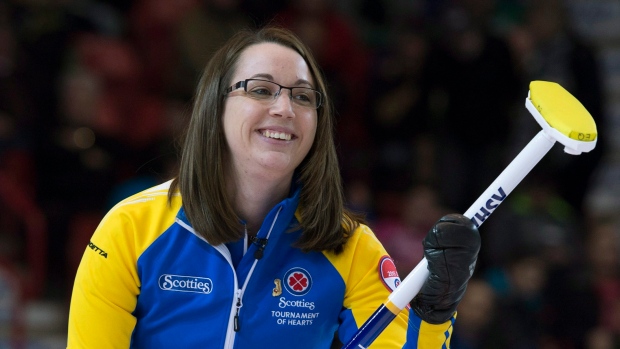Nov 17, 2015
Mixed doubles curling proves to be a curiosity and a challenge
Mixed doubles curling is going to be in the next Olympics but for most Canadian fans, it’s still a novelty.
By Bob Weeks

Mixed doubles curling is going to be in the next Olympics but for most Canadian fans, it’s still a novelty. In fact, so strange is the game, that at the Wall Grain Mixed Doubles Classic, a major event being held at the Oshawa Curling Club this week, spectators were given sheets explaining the rules.
While the game is certainly different, the players on the ice for this tournament – consciously held right after a Grand Slam event – were familiar. The eight sheets were littered with Canadian, world and Olympic champions all trying to get a grasp on the variation of the centuries-old sport.
“It’s definitely tough,” stated Winnipeg skip Mike McEwen, who partnered with his wife Dawn, who regularly throws first rocks for Jennifer Jones. “I thought it would be hard, but the pace and everything is really different.”
“There’s a big learning curve right now,” added Ryan Fry, a member of the 2014 gold medal winning men’s rink. “We have to go to school for the next few years.”
That’s the truth. While Canada may be the powerhouse in the four-player, traditional version of curling, it’s way behind when it comes to mixed doubles. It’s sixth in the World Curling Federation rankings and hasn’t been on the podium at the world finals since 2009.
As its name suggests, mixed doubles is played by teams of one woman and one man. Six rocks are played each end with two of those – one for each team – being positioned before the first thrown rock is played. Players throw either the first and fifth rocks of the end, or the second, third and fourth.
Some modifications were made at the start of this year – such as eliminating the necessity of one player to always be in the house – and that’s only added to the curiosity as well as the challenge.
“I think in most people’s minds, it’s a little quirky,” said Jeff Stoughton, “but it’s not going anywhere.”
Stoughton retired from competitive play last year and was looking for a way to stay involved in the game. Curling Canada invited him to be the program manager and he gladly accepted, putting him at the forefront of the newly minted Olympic sport.
He’s trying his best to encourage top names to try the version, which has been called curling’s answer to beach volleyball, as well as get more dedicated mixed doubles teams playing.
“We’re playing catch up, that’s for sure,” he said. “It’s really been big in some European countries where they may not have four top men players or four top women players, but if they can get one good man and woman, they can compete. And they do.”
Hungary, a country that has never been considered one of the game’s powerhouses, won the world championship in 2015, marking its second victory in three years. New Zealand, Austria and the Czech Republic have all won medals.
With the Olympics in mind, many European countries have mixed doubles specialists, teams that play only that version. There is a circuit of eight to 10 events compared to just three significant tournaments in Canada.
The closest Canada has to a dedicated mixed doubles team may be the husband-and-wife duo of Wayne and Kim Tuck, who won the Canadian championship in 2014. Both play on competitive men’s and women’s teams, but next year, they are planning to make mixed doubles their primary sport.
“The teams that do well are the ones that just focus on mixed doubles,” said Tuck. “I think the hope for some of the elite teams is that if they don’t make the Olympics with their [four-player] teams, they’ll try mixed doubles and I don’t think that will work.”
McEwen agrees somewhat but believes that in the first Olympic go-around, there will be curlers who will double up.
“It’s tough to do both,” he acknowledged. “If you’re in top four-person curling, I would think it would be really challenging to do both at a high level. Not to say that there won’t be some who try that. This is a tryout year for us to see how much time we can actually put into it.”
Stoughton believes this first Olympic cycle will be a learning curve for a lot of players but hopes that by the 2022 Games, the specialists will be as common as skiers who chose downhill or slalom. He’s also hoping for some television coverage that goes beyond just mixed doubles’ play in the Continental Cup.
By then, he hopes the sport will have advanced so much that, at the very least, the crowd won’t need handouts to explain the rules.